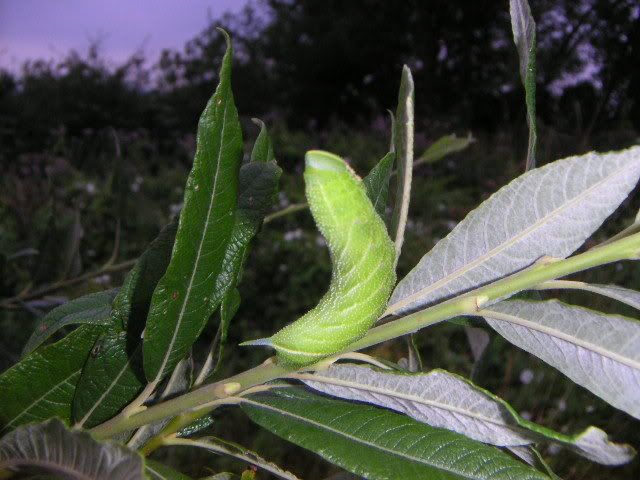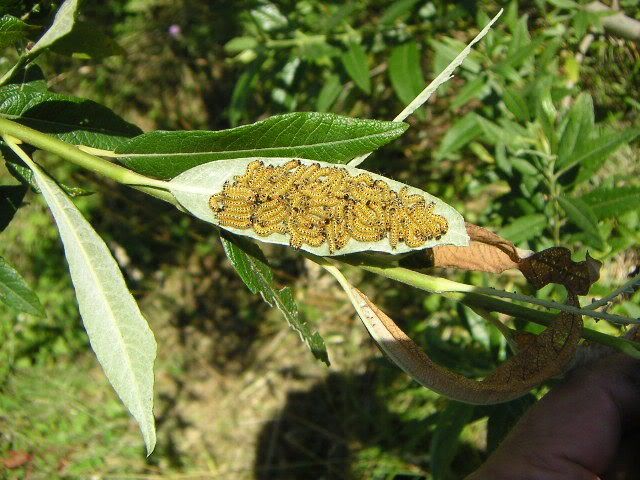Hi Susie,
I forgot to add that perhaps the main difference between 'Master Trees' for Emperors and Brown Hairstreaks is that the assembly points for BHs are typically at locally low points (valley bottoms etc.). I suspect that you have BHs spread over a wide area around your BBH site (info given via Email), in which case there will be a number of MTs in the general vicinity. Look for particularly ash trees in low-lying, sheltered, sunny spots in the more open countryside to the South of that main road.
Jack's point re Purple Hairstreaks - this species doesn't use 'Master Trees'. The MT model is used by species that typically occur at much lower population densities, as it allows them to meet up with prospective mates which would otherwise be spread over a wide area of the countryside. Rather like a Young Farmer's Dance at the local village hall. Purple Hairstreaks are (at least within large parts of their range) very common butterflies and in Sussex almost every decent oak will support plenty. They're hugely under-recorded, but on sunny evenings after 6 or 7 pm the sunlit crowns become alive with dancing Hairstreaks making whoopee.
Neil
Taking Purple Emperors.
- Jack Harrison
- Posts: 4631
- Joined: Wed Jan 18, 2006 8:55 pm
- Location: Nairn, Highland
- Contact:
Re: Taking Purple Emperors.
Sussex Kipper:
Jack
Perfect analogy!Rather like a Young Farmer's Dance at the local village hall
Jack
-
Cotswold Cockney
- Posts: 487
- Joined: Sun Dec 31, 2006 9:39 pm
- Location: GLOUCESTERSHIRE
Re: Taking Purple Emperors.
Nothing much on the box tonight so a little ramble on Butterfly thingies.....Sussex Kipper wrote:Hi Susie,
Much Snipped ....
Purple Hairstreaks are (at least within large parts of their range) very common butterflies and in Sussex almost every decent oak will support plenty. They're hugely under-recorded, but on sunny evenings after 6 or 7 pm the sunlit crowns become alive with dancing Hairstreaks making whoopee.
Neil
My own observations in mainly Gloucestershire confirm the Purple Hairstreak is indeed a very common and widespread butterfly and easily overlooked. Even lone Oaks can support a good colony. Thirty plus years ago, when I used to sample Oaks using a beating tray in many southern and central counties during May, it was rare that a Purple Hairstreak larva or two did not appear on the tray from the lowest branches after only one or two jars of those reachable lower branches with the stick. Additionally, again from my own observations up until the 1970s-80s, the same was true of the White-Letter Hairstreak locally in my experience. Never beat for those ~ no need ~ the butterfly being largely overlooked and that late evening active Hairstreak high up around and over the trees at the woodland edge was not the Purple as first thought. Using the Zeiss 10 x 50 binoculars revealed it to be a W-LH on many occasions. In this way I turned up several W-LH breeding trees within a mile or two of my home. I even saw a fresh female alight in the very centre of the road in the very middle of Gloucester 'Cross' where, prior to being wholly pedestrianised, traffic flowed in all four 'Cross' directions across N-S-E-Westgate streets without squashing the butterfly. There were fine specimen Wych elms nearby in Gloucester park ~ all since gone. Nowadays now they may not be so common or widespread ~ but, could still be because I have not seriously searched ~ they are so easily overlooked like the PH.
It is relatively easy to spot ova, larvae and indeed pupae of the W-LH on the lower branches of Elms. I first found W-LH early stages on Wych elms as a schoolboy back in the 1950s. Worth repeating that I've since found W-LH ova on Blackthorn in areas noted for those two other Hairstreaks which regularly use this plant for their ova. There could be higher densities of earlier stages of both PH and W-LHs on the higher branches of their trees but, I have never tried to search those. Using binoculars, I can confirm that both Purple and White-Letter Hairstreaks lay ova higher up on the trees, possibly in far greater numbers up there.
When I first viewed my own little 'nature reserve' prior to purchase nearly twenty years ago, it was a very sunny July day in Gloucestershire. The field was neglected farm pasture becoming overgrown at the time and was alive with several species of 'Browns' including large numbers of Marbled Whites... another 'Brown'.
As it happened, we were in a bidding competition with an adjoining wealthy landowner and my bid was always topped and I finally believed the deal could not be done and so dropped out. Six months later I got a surprise phone call from the selling agents enquiring if I was still interested in the field at my previous final bid. So, the deal was done as the previous top offer backed out .... Lose some ... Win some ?..... well yes, sometimes... that field has been a joy for my family and friends. Indeed I taught both my sons and lots of their friends how to handle a car there in the early days which was another bonus. Both then went on to BSM and both passed their driving tests first time...learning how to control and handle a car in a safe environment before taking to the road is a great advantage I feel.
The mishapen oval track they made around much of the perimeter is still clearly visible from those Satellite or Aircraft 'Earth' pictures from high up over the landscape. Meantime those Oak Acorns sewed earlier by local Jays years ago are quite tall now. Indeed, part of the field has become thicket and wooded ~ the central area largely grassy with a good mixture of flowers including a good variety of insect foodplants. I have also planted several Elm species some of which I'm told are more resistent to the dreaded disease. The track is also useful for access and to use for a tour to observe what's about in various other parts. Here's my son aged about 15-16 learning how to handle a reasonably powerful car ( an MG Montego 2.0 EFi ) and helping to keep the track open:~

That's digital image of a film print ~ hence quality. Those blurred trees and bushes in the background are mostly mature Blackthorn....
Some of those sapling Oaks are quite tall now and there's a good clump of them which I may have to thin out in later years. I've removed much of the overgrown and choking Bramble, Wild Rose ( what a spiteful plant! ) and Hawthorn scrub to allow these young Oaks, Sallows, Elms, Celtis, Zelcova, Cowslips et al I've planted to develope further. I have observed the PHs over these smaller trees in good numbers in recent flight seasons. Must look for Ova on them when time allows ~ I think they're sufficientkly mature for ova now ~ certainly seen the females on them but, not observed ovipositing on them yet. Matter of time I guess.
On the willows and sallows I've planted I've found Hawk Moth and other larger moth species larvae. Semi-retired 'OAP' (
Cannot come quick enough. ..... Roll on!
EDIT @ 01:35 to include some Moth larvae images seen on the Narrow Leaved Sallow I planted:
Poplar Hawk Larva ~ nearly fully grown:

Young brood of Buff Tip Larvae:

Nearly fully fed Buff Tip larvae ~ they can effectively strip a branch in no time ..

Cotswold Cockney is the name
All aspects of Natural History is my game.
All aspects of Natural History is my game.
Re: Taking Purple Emperors.
Thanks for posting, CC. Fascinating stuff as usual. 
I have Purple hairstreak on the oak in my garden too.
I have Purple hairstreak on the oak in my garden too.
Re: Taking Purple Emperors.
Thanks CC - I enjoyed reading that.
I have looked for WLH early stages the last couple of years, which can be easier than looking for the adults - they are easier to photograph, for certain. In 2007 I had some success but in 2008 there was nothing to be seen. Possibly a consequence of the poor summer of 2007 (the early spring that year meant the larvae had developed early and emerged just in time to be hit by the rain). This spring I also noted few wych elms in flower and almost none set seed (which the trees do in May, before they come into leaf). As the larvae eat the flowers and seeds in their early instars I feared the worst, but the butterflies actually seemed to do reasonably. They fly early, too - about 9a.m. is a good time.
I have yet to find WLH on hedgerow elm (there is a lot of it round here) but the larvae do manage on scrappy elms from about 20 feet high, often in tree-lines. Here are a couple of examples.
Elm next to a railway bridge at Hurcot in the Poldens - there were slightly larger specimens on the other side and the hairstreaks were flying around a taller ash tree just out of shot to the left.
Elm in seed in the abandoned quarry in Bathampton Down. There are actually three trees here, the largest of which is an ash! In 2007 I found a larva and a pupa on the elms. Although I visit the quarry most weeks during the summer, I have never seen the adults there.
I have looked for WLH early stages the last couple of years, which can be easier than looking for the adults - they are easier to photograph, for certain. In 2007 I had some success but in 2008 there was nothing to be seen. Possibly a consequence of the poor summer of 2007 (the early spring that year meant the larvae had developed early and emerged just in time to be hit by the rain). This spring I also noted few wych elms in flower and almost none set seed (which the trees do in May, before they come into leaf). As the larvae eat the flowers and seeds in their early instars I feared the worst, but the butterflies actually seemed to do reasonably. They fly early, too - about 9a.m. is a good time.
I have yet to find WLH on hedgerow elm (there is a lot of it round here) but the larvae do manage on scrappy elms from about 20 feet high, often in tree-lines. Here are a couple of examples.
Elm next to a railway bridge at Hurcot in the Poldens - there were slightly larger specimens on the other side and the hairstreaks were flying around a taller ash tree just out of shot to the left.
Elm in seed in the abandoned quarry in Bathampton Down. There are actually three trees here, the largest of which is an ash! In 2007 I found a larva and a pupa on the elms. Although I visit the quarry most weeks during the summer, I have never seen the adults there.
Re: Taking Purple Emperors.
Reintroduction of the Large Copper appears to be awaiting a suitable amount of habitat to be restored:
http://www.springerlink.com/content/t0833j7545tq5346/
(full article requires academic log-in, which I don't have, but the abstract gives the gist).
http://www.springerlink.com/content/t0833j7545tq5346/
(full article requires academic log-in, which I don't have, but the abstract gives the gist).
-
Cotswold Cockney
- Posts: 487
- Joined: Sun Dec 31, 2006 9:39 pm
- Location: GLOUCESTERSHIRE
Re: Taking Purple Emperors.
Back in the 1970s-early 80s, I bred L. d. batavus in large numbers on growing Great Water Dock ~ a lot of work I can tell you. Even breeding only 100 is hard work preparing and maintaining suitable conditions in captivity. I have prints of these efforts and will dig them out for digital copying. Very few images of the adults, my pictures are mainly of the earlier stages of those butterflies I bred. Captive breeding has always been my main interest.
One thing I found that is absolutely essential for these butterflies ( batavus ) is for sufficient numbers of suitable dead Great Water Dock leaves in which the little larvae can hibernate for several months over the autumn and winter. Some of the GWD leaves are huge! Even potted, it can grow to a large size. By suitable, I have in mind that those dead leaves containing the little overwintering larvae must NEVER become submerged or saturated even for a brief period as may happen during a freak heavy flash downpour. That is essential. If the dead leaves become moistened where the larvae are resting on their silk pads, mould soon appears and that is the end of the larvae. The common Dock is not suitable for hibernating larvae. The leaves are much more prone to suffer immediate collapse and become mouldy with minimal moisture contact. Fatal for the little hibernating larvae. Once successfully out of hibernation, ordinary Common Dock can be used but, the GWD is superior in every way and provides the larger, vibrant healthy specimens far more reliably provided larvae have access to healthy growing plants.
For a successful colony to be established in the UK, it will be essential to ensure that the water levels can be maintained, or, controlled so that the dead leaves on the plants do not become swamped or submerged during the long winter hibernation period. Failure to achieve that will undermine any such attempts at successful reintroductions to the UK's countryside.
One thing I found that is absolutely essential for these butterflies ( batavus ) is for sufficient numbers of suitable dead Great Water Dock leaves in which the little larvae can hibernate for several months over the autumn and winter. Some of the GWD leaves are huge! Even potted, it can grow to a large size. By suitable, I have in mind that those dead leaves containing the little overwintering larvae must NEVER become submerged or saturated even for a brief period as may happen during a freak heavy flash downpour. That is essential. If the dead leaves become moistened where the larvae are resting on their silk pads, mould soon appears and that is the end of the larvae. The common Dock is not suitable for hibernating larvae. The leaves are much more prone to suffer immediate collapse and become mouldy with minimal moisture contact. Fatal for the little hibernating larvae. Once successfully out of hibernation, ordinary Common Dock can be used but, the GWD is superior in every way and provides the larger, vibrant healthy specimens far more reliably provided larvae have access to healthy growing plants.
For a successful colony to be established in the UK, it will be essential to ensure that the water levels can be maintained, or, controlled so that the dead leaves on the plants do not become swamped or submerged during the long winter hibernation period. Failure to achieve that will undermine any such attempts at successful reintroductions to the UK's countryside.
Cotswold Cockney is the name
All aspects of Natural History is my game.
All aspects of Natural History is my game.
Re: Taking Purple Emperors.
RE: Large Copper - the Great Fen awaits!
http://www.greatfen.org.uk/
N
Hope they take on board the advice that CC is giving!
http://www.greatfen.org.uk/
N
Hope they take on board the advice that CC is giving!
"Conservation starts in small places, close to home..."
